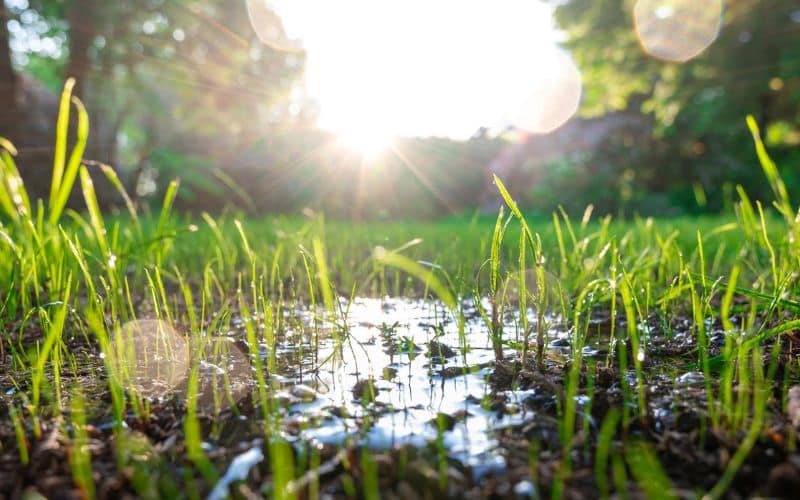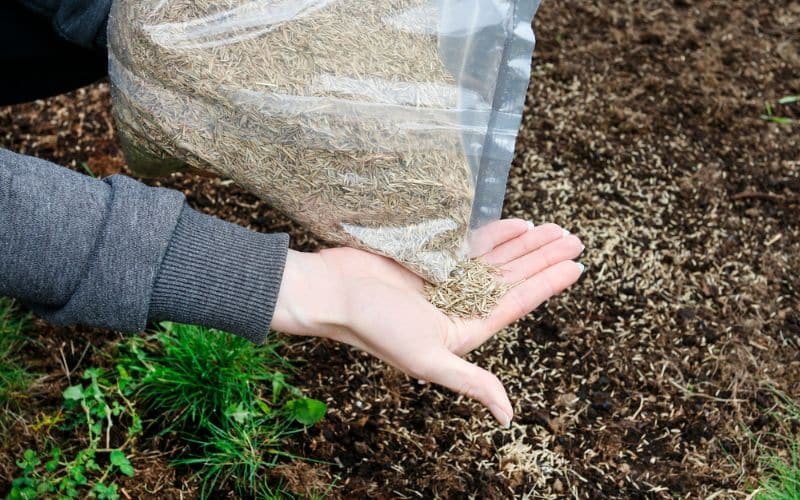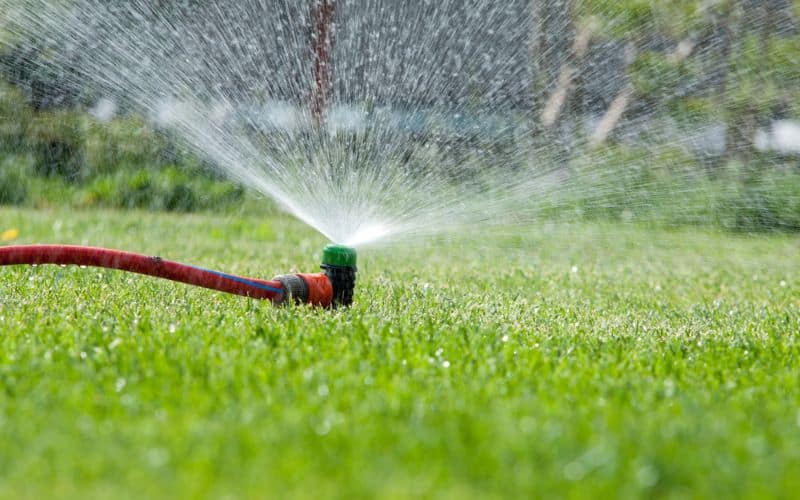
When you’re looking to create a lush lawn, understanding grass seed germination rates is crucial. Timing is everything, and the success of your green space hinges on knowing when and how to sow your seeds. With soil temperature needing to be at least 8°C for successful germination, you’ll find that the season plays a significant role in your seeding success.
Grass seed types have varying germination periods, from as quick as 5 days for Rye Grass to up to 30 days for Bermuda. In this article, you’ll discover how to maximise germination rates and what factors, like soil moisture and temperature, can make or break your lawn goals. Whether you’re planting anew or overseeding, you’re in the right place to learn the ins and outs of grass seed germination.
Factors Affecting Grass Seed Germination Rate
When you’re aiming for a lawn that stands out, understanding the factors impacting the germination rate of grass seeds is essential. One pivotal element is soil temperature, with most types of grass seeds requiring at least 8°C to successfully germinate.
The type of grass you choose has a direct effect on how quickly you’ll see results. Here’s a quick rundown of germination periods for common grass seeds:
| GRASS SEED TYPE | NUMBER OF DAYS TO GERMINATE |
|---|---|
| Bentgrass | 10 – 15 |
| Bermuda | 10 – 30 |
| Bluegrass | 20 – 30 |
| Buffalo Grass | 14 – 28 |
| Centipede | 14 – 21 |
| Fescues | 7 – 15 |
| Rye Grass | 5 – 10 |
Remember, these figures represent the time until grass may first appear or until most of the seeds have sprouted. The germination rate mentioned on seed packages also plays a crucial role. Typically, 90-95% is preferred, but don’t be surprised to find rates around the 80% mark. An 85% germination rate means out of 100 seeds planted, about 85 are expected to thrive.
Besides temperature, other significant factors include:
- Soil Moisture: Seeds need enough water pre-sowing to create a favourable environment.
- Soil Quality: Different seeds thrive in different soils. Well-aerated, nutrient-rich topsoil is ideal.
- Oxygen Availability: Compacted or heavy sandy soils can stifle seed growth due to low oxygen levels.
- Seasons: Plant cool-season grasses such as perennial ryegrass in the autumn, while warm-season types grow better in the spring or summer.
Moreover, you must consider storage conditions of seeds. Prolonged storage or poor conditions can dramatically reduce germination rates. Before sowing, it’s beneficial to remove any dead grass from your lawn or use a spreader for even seed distribution which will also contribute to a homogenous germination process.
Optimal Conditions for Grass Seed Germination
Temperature
When gearing up for lawn seeding, you must acknowledge that temperature plays a pivotal role in grass seed germination. Unlike the misconception that air temperature dictates germination, soil temperature is what counts. The magic numbers for soil temperature begin at 50 degrees. For cool-season grasses, you’re looking at a minimum range of 45-55 degrees while warm-season variants need it warmer, setting the benchmark at 55-65 degrees. Remember, soil acts as an insulator and may lag behind the ambient temperature. Hence, it’s crucial to measure the ground warmth independently to ascertain the ideal time for sowing your seeds.
Moisture
Another cornerstone for successful germination of grass seeds is consistent moisture—neither sparse nor in excess. Adequate moisture ensures that seeds don’t dry out or rot. The seed’s moisture content must maintain an internal level of 10-20 percent. It’s essential to follow guidelines for watering new grass seeds to maintain this balance. Keep the soil uniformly moist but beware of overwatering, which can be just as detrimental as drought. Periodic but light watering might be your safest bet, ensuring the soil never completely dries out nor becomes waterlogged.
Light
Light is essential for photosynthesis, the process through which grass converts sunlight into the energy needed for growth. Your seeds need a helping hand from a well-lit environment, requiring at least four hours of direct sunlight daily. For areas with shade issues, consider pruning nearby trees or shrubs to invite more sunlight, enhancing the germination process and subsequent grass growth. Light also interacts with temperature, influencing soil warmth and, in turn, impacting germination and growth rates.
Choosing the Right Grass Seed for Your Needs
When it’s time to select grass seed, taking into account the specific conditions of your yard is crucial. Sunlight exposure, the size of your lawn, and anticipated foot traffic are variables that determine which grass seed will lead to lush growth.
For sunlight exposure, categorize your lawn’s areas as full sun, partial sun, or shade. Full sun areas require grasses that can endure prolonged exposure, while shady areas need varieties adapted to lower light levels. Classifications are as follows:
- Full Sun: At least 6 to 8 hours of direct sunlight daily, suited for Bermudagrass, Kentucky bluegrass, and Zoysiagrass.
- Partial Sun: Receives 4 to 6 hours of sunlight, accommodating a range of grass types.
- Shade: Less than 4 hours of direct sunlight, necessitates shade-tolerant varieties like Fine fescue and certain ryegrasses.
Regarding lawn size and seed spreaders, a drop spreader is perfect for smaller lawns under 5,000 sq ft. It provides precision, which is integral for intricate landscaping. On the other hand, large lawns benefit from a broadcast spreader due to its ability to cover more ground faster.
For areas with high foot traffic, select durable cultivars that can recover quickly from wear. Considerations about your lawn’s characteristics narrow down your options:
- Small, Precision-Needed Lawns: Drop Spreader
- Large, Open Lawns: Broadcast Spreader
- High Foot Traffic: Select Durable Cultivars
Once spread, lightly rake seeds into the soil and pass over with a roller to ensure optimal seed-to-soil contact. The correct depth is about 1/4 inch – deep enough to secure the seed, yet shallow enough to receive sunlight and sprout effectively.
Preparing the Soil for Grass Seed Germination
Achieving a lush green lawn is within your grasp when you pay attention to each step of the grass seed germination process. Soil preparation is paramount; it’s the foundation for healthy growth right from the start. Let’s delve into the specifics.
Soil pH
Your lawn’s growth potential significantly hinges on the Soil pH Level. A pH range of 6.0 to 7.0 is optimal for most grass varieties, creating a conducive environment for nutrient absorption. If your soil test reveals an imbalanced pH, you’re tasked with amending it. Alkaline pH can be lowered by introducing sulfur, and conversely, acidic soils can be corrected by adding lime. This careful adjustment will bolster the soil’s fertility, ultimately providing your grass seeds with a hospitable germination bed.
Soil Aeration
Soil aeration can be a game-changer for your lawn. It involves perforating the soil to allow air, water, and nutrients to penetrate the root zone, vital for robust plant growth. For compacted soil, especially the kind that struggles to sustain healthy grass, core aeration is your ally. This process removes small plugs of soil, easing soil compaction and fostering better root development. Remember, healthier roots translate to a more resilient and verdant lawn.
Soil Compaction
Soil compaction is a common culprit of germination issues; it hinders proper root expansion and reduces oxygen availability. Compacted soil lacks the porous spaces needed for water and nutrient movement, stifling seed growth. You’ll need to alleviate this by breaking up the soil. Tools like garden rakes or rototillers can effectively loosen the compacted layers. Ensuring your planting ground has a blend of aeration and de-compaction strikes a balance; it’s not just about nutrient-rich soil but also about the right soil texture and structure to support germination and growth.
By systematically addressing soil pH levels, ensuring adequate aeration, and resolving soil compaction, you’ll set the stage for a successful germination process. Your grass seeds stand the best chance when nestled in a prepared and fertile soil, ready to sprout into a healthy and thriving lawn.

Seeding Techniques for Maximizing Germination Rate
Once you’ve prepared the soil for grass seed germination, it’s time to delve into seeding techniques. Each method offers distinct advantages. By choosing the best approach for your specific situation, you strengthen the chances of achieving a high germination rate.
Broadcasting
Broadcasting is one of the simplest and most common methods for sowing grass seed. This technique involves scattering seeds over the soil surface manually or by using a broadcast spreader. It’s efficient for both new lawn establishment and overseeding large areas. Benefits of broadcasting include:
- Even distribution of seeds, ensuring comprehensive coverage
- Faster application over expanses, reducing labor time
- Less equipment required compared to other methods
To increase efficiency, use a broadcast spreader which covers large areas quickly. Broadcast spreaders work by flinging seeds in a wide swath, which is ideal for open spaces. When using this method, aim for the optimum seeding rate which considers factors such as seed size, growth habit, and germination percentage.
Overseeding
Overseeding is crucial when you want to rejuvenate an existing lawn. By planting new grass seeds directly into the existing turf, you claw back vitality and lushness. Listed below are the reasons why overseeding is pivotal for lawn maintenance:
- Minimises weed occurrence by creating a dense turf
- Addresses bare or damaged patches effectively
- Enhances the visual appeal of your lawn with fresh, vigorous growth
When overseeding, distribute the seeds uniformly to avoid clumping and ensure thorough contact with the soil. Regular watering plays a vital role; maintain the seeds moist — but not drenched — until germination is complete. By doing so, the success rate can climb to a notable 90 to 95 percent with proper care. It’s recommended to water the new seeds two to three times daily with a gentle spray.
Hydroseeding
Hydroseeding is an advanced seed application technology. It’s particularly fitting for sloped terrains and large commercial areas. The process blends seed, mulch, water, and fertilizer into a homogenous slurry which is then sprayed onto the soil. The rich, protective mulch layer encourages speedy germination and growth. Advantages of hydroseeding include:
- Rapid application over expansive or difficult-to-reach sites
- Improved seed-to-soil contact thus enhancing the germination rate
- Reduced soil erosion thanks to the protective mulch layer
A remarkable aspect of hydroseeding is the customizability it offers, allowing for tailored seed mixes that meet the unique needs of your lawn. Moreover, its efficacy in combating erosion helps stabilize areas prone to soil degradation, giving it an edge in landscaping projects with ecological considerations.

Caring for Newly Germinated Grass
Once your grass seed has successfully germinated, it’s crucial to give the young grass the care it needs to establish robustly. You’ve put in the hard work; now it’s time to ensure that it pays off.
Watering
After germination, consistent watering is essential. Your new grass needs adequate moisture to continue developing strong roots.
- In the initial stages post-germination, aim to keep the top inch of soil moist but not waterlogged.
- Reduce frequency gradually as your lawn matures to encourage deeper root growth.
- Morning watering is best to reduce evaporation and fungal diseases.
By the week 9 mark, transition to a more conventional watering schedule, adjusting for rainfall to provide 1 inch of water per week.
Fertilizing
Balanced fertilization during this stage will support growth without encouraging diseases or weed competition.
- Use a starter fertilizer with a balanced NPK ratio that matches your lawn’s needs as indicated by a soil test.
- Avoid high nitrogen content early on to prevent weak root systems.
Fertilizer schedules vary, but generally, you’ll want to apply it every six to eight weeks during the growing season.
Weed Control
Efficient weed control is a game-changer for your fledgling grass.
- Manual removal of weeds ensures they don’t steal nutrients from your grass.
- Postpone herbicide use until your lawn has been mowed several times to avoid damaging delicate grass shoots.
Regular maintenance, such as proper mowing and aeration, will contribute to less weed invasion over time by promoting a denser lawn that leaves little room for weeds to emerge.
By diligently following these steps, you’ll provide a solid foundation for your new grass to thrive, reducing the risk of patchiness and promoting an even, lush lawn. Keep monitoring and adjusting your care practices to match the needs of your lawn as it matures.
Common Issues Affecting Grass Seed Germination
Diseases
One of the biggest hurdles in achieving a lush lawn is disease, which can significantly hinder seed germination and young seedling growth. Fungal diseases such as Pythium, Snow Mold, and Brown Patch thrive in moist conditions, which are also crucial for seed germination. The key to combating these diseases lies in:
- Ensuring proper soil drainage to prevent excessive moisture that fosters fungal growth.
- Choosing grass seeds that are coated with fungicides, especially if you’ve faced diseases in the past.
- Avoiding sowing during humid or excessively wet conditions when fungi are more active.
Pests
Your dream of waving blades of grass can swiftly turn into a nightmare by the action of pests. Birds, insects, and rodents treat grass seeds as a food source, and their presence can result in a poor germination rate. Strategies to deter these pests include:
- Using seed blankets or burlap sheets to cover seeds and reduce visibility and accessibility to birds.
- Applying pest deterrents that are safe for new seedlings.
- Encouraging beneficial insects and birds that prey on pest species, thus naturally managing this threat.
Poor Soil Conditions
Poor soil conditions are often an overlooked yet critical factor in grass seed failure to thrive. Factors such as compaction, low fertility, and incorrect pH levels can all play a part in impeding germination. To rectify these issues:
- Conduct a soil test prior to sowing to pinpoint deficiencies and pH imbalances.
- Aerate the lawn to alleviate compaction and improve oxygen flow to seeds.
- Amend the soil with organic material if the test indicates poor fertility.
By addressing diseases, pests, and soil conditions, you can elevate your chances of a successful and robust grass germination. Remember, vigilant observation and proactive intervention are your best allies in nurturing young grass to maturation.
Conclusion
Unlocking the secret to a lush lawn starts with understanding the delicate balance of conditions needed for grass seed germination. You’ve learned that soil temperature, moisture, and sunlight are pivotal factors, and preparing your soil with the right pH and aeration can make all the difference. Remember, combating common issues like diseases and pests is crucial. By ensuring proper soil drainage and considering fungicide-coated seeds, you’re setting the stage for a vibrant, green expanse. Keep these tips in mind and you’ll be well on your way to creating the perfect environment for your grass seeds to thrive.
Colin Macmillan is a seasoned entrepreneur and the CEO of Riverwood Landscape, a leading landscaping company based in Canada. He has been at the helm of the company since leaving high school, demonstrating his strong leadership skills and business acumen.
Colin’s expertise lies in various aspects of landscaping, including lawn care, interlocking, sod installation, and commercial maintenance. His hands-on approach and dedication to the craft have been instrumental in building Riverwood Landscape into a reputable brand.
One of his most notable achievements is the creation of a successful landscape franchise that services multiple locations. This accomplishment underscores his strategic thinking and ability to scale operations effectively.
Colin has also had the privilege of working with Guelph Hospital for landscaping and maintenance, a testament to the trust and reliability that his company has earned over the years.
His professional mission is to offer the best services and experiences for customers, a goal that he tirelessly pursues. Colin’s commitment to excellence and customer satisfaction continues to drive the growth and success of Riverwood Landscape.








